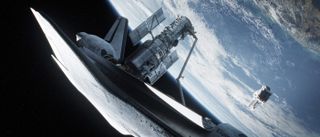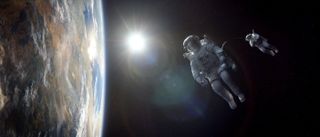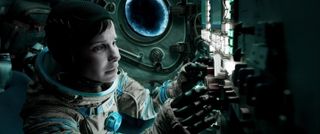The Spaceships of 'Gravity': A Spacecraft Movie Guide for Astronauts

While Sandra Bullock and George Clooney will be praised for their performances in "Gravity," some of the true stars of the new film don't have any lines at all.
"Gravity" — a movie focused on the harrowing journey of two astronauts trying to get back to Earth after disaster strikes — puts the past, present and future of manned spaceflight on display through the spacecraft that are central to the film. The spacecraft — written into the movie by writer/director Alfonso Cuarón and his son Jonás — show the diverse range of machinery responsible for allowing humans to live and work in space.
Many of the ships used in the film are still flying today, but some pay tribute to a bygone era of human spaceflight while others look to the future. Read about the varied spaceships of "Gravity" below, but keep an eye out for fast-moving spoilers: [See Photos from the new film "Gravity"]
NASA's Space Shuttle
Gravity's opening moments feature a dreamy looking space shuttle flying high above Earth on a mission to service the Hubble Space Telescope. The shuttle itself is dubbed Explorer, and although the name is fictional, it bears a striking resemblance to the real reusable space shuttles that flew missions from 1981 to 2011.
NASA's space shuttles were the first reusable spacecraft to fly humans into orbit. The space agency's five shuttles — Columbia, Atlantis, Discovery, Endeavour and Challenger — flew a combined total of 135 missions into space.
In the movie, Explorer is flying the 157th shuttle mission and the orbiter is the first casualty of a space junk chain reaction making its way around the planet.
Get the Space.com Newsletter
Breaking space news, the latest updates on rocket launches, skywatching events and more!

The Manned Maneuvering Unit (MMU)
The jet pack used by astronaut Matt Kowalski (played by George Clooney) is not a fictional creation. NASA's Manned Maneuvering Unit was used on space shuttle missions in 1984 to perform untethered spacewalks.
Today, astronauts fly with a smaller version of the MMU called a SAFER (Simplified Aid for EVA Rescue) as a safety contingency on spacewalks outside of the International Space Station.

The International Space Station
"Gravity" is not kind to the International Space Station. The $100 billion orbiting laboratory is annihilated by flying space junk but not before the interior of the outpost dramatically catches fire during one of the more intense scenes of the film.
In reality, a rotating crew of astronauts and cosmonauts from around the world staff the non-fictional, five bedroom house-sized space station. At the moment, NASA's Karen Nyberg and Mike Hopkins, Italian astronaut Luca Parmitano and Russian cosmonauts Oleg Kotov, Sergey Ryazanskiy and Fyodor Yurchikhin make up the station's Expedition 37 crew.

Russia's Soyuz Spacecraft
The Russian-built Soyuz spacecraft is currently the only capsule that can deliver crewmembers to and from the International Space Station. A Soyuz comes in three parts: the orbital module, the descent module and the propulsion module. The orbital and propulsion modules are both discarded before the craft re-enters Earth's atmosphere, leaving the descent module to bring the crew safely home.
Boosters used to soften the capsule's fall to Earth's surface engage when the craft is approaching the ground, but in "Gravity" those boosters play a different role. Ryan Stone (played by Sandra Bullock) uses the descent module during her harrowing trip around the planet.
WARNING: Big spoilers ahead so stop reading now if you want to be surprised.
China's Tiangong Space Station
The only spacecraft in the movie that hasn't flown in space is China's Tiangong Space Station. While the country has plans to launch a station like the one depicted in "Gravity" sometime in the future, it isn't flying through space yet. China's new 60-ton space station's assembly should be completed in 2020.
China launched its Tiangong 1 module — which translates to "Heavenly Palace" — in 2011 as a precursor to the country's station.
China's Shenzhou Spacecraft
Based on Russia's Soyuz, the Shenzhou spacecraft is designed to safely shuttle Chinese astronauts (called taikonauts) to and from orbit. In "Gravity," Stone hops into a Shenzhou as a last ditch effort to get back to Earth after her space shuttle, the International Space Station and Soyuz spacecraft are all destroyed.
China's Shenzhou spacecraft (the name means "Divine Vessel") first launch an Chinese astronaut into space in 2003.
Honorable Mention: The Hubble Space Telescope
Hubble isn't strictly a spaceship, but it is one of the most beloved science instruments ever launched into orbit. NASA's shuttles visited the astronomy instrument for multiple servicing missions and it is responsible for creating some of the most iconic images of the universe ever captured. The Explorer shuttle is on a servicing mission to Hubble when both are destroyed.
"Gravity" is out in theaters nationwide now.
Follow Miriam Kramer @mirikramer and Google+. Follow us @Spacedotcom, Facebook and Google+. Original article on SPACE.com.
Join our Space Forums to keep talking space on the latest missions, night sky and more! And if you have a news tip, correction or comment, let us know at: community@space.com.

Miriam Kramer joined Space.com as a Staff Writer in December 2012. Since then, she has floated in weightlessness on a zero-gravity flight, felt the pull of 4-Gs in a trainer aircraft and watched rockets soar into space from Florida and Virginia. She also served as Space.com's lead space entertainment reporter, and enjoys all aspects of space news, astronomy and commercial spaceflight. Miriam has also presented space stories during live interviews with Fox News and other TV and radio outlets. She originally hails from Knoxville, Tennessee where she and her family would take trips to dark spots on the outskirts of town to watch meteor showers every year. She loves to travel and one day hopes to see the northern lights in person. Miriam is currently a space reporter with Axios, writing the Axios Space newsletter. You can follow Miriam on Twitter.
